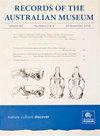The Leopard Mantis Shrimp, Ankersquilla pardus, a new genus and species of eurysquillid from Indo-West Pacific coral reefs
IF 0.8
4区 生物学
Q4 ZOOLOGY
引用次数: 0
Abstract
The mantis shrimp superfamily Eurysquilloidea Manning, 1977, with the single family Eurysquillidae Manning, 1977, contains six genera and 32 species, the majority of which occur in the Indo-West Pacific. Here, we describe a new species of eurysquillid, Ankersquilla pardus, from the central and western Pacific that cannot be assigned to any recognized genera, and, accordingly, propose a new genus for its reception. Ankersquilla pardus is unique in Eurysquilloidea in bearing three teeth on the dactylus of the raptorial claw. Similar raptorial claw armature is otherwise known only in the Parasquilloidea and Pseudosquillidae (Gonodactyloidea). All other eurysquillloids have four or more teeth on the dactylus of the raptorial claw. The most unusual aspect of Ankersquilla pardus, however, is the finely spinose posterior abdomen and telson, which resembles members of the Coronididae (Lysiosquilloidea). Although superficially similar to some coronidid lysiosquilloids, the ovate maxilliped 3–4 propodi, ventrally arising intermediate and lateral denticles of the telson, and form of the male pleopod 1 endopod show Ankersquilla pardus to be a eurysquilloid. Records of the Australian Museum a peer-reviewed open-access journal published by the Australian Museum, Sydney communicating knowledge derived from our collections ISSN 0067-1975 (print), 2201-4349 (online)豹纹螳螂虾,豹纹螳螂虾,印度-西太平洋珊瑚礁的一种新属
螳螂虾超科Eurysquilloidea Manning, 1977,与单科Eurysquillidae Manning, 1977,包含6属32种,其中大部分出现在印度-西太平洋。在这里,我们描述了一种新的eurysquild, Ankersquilla pardus,来自中太平洋和西太平洋,不能被分配到任何公认的属,因此,提出了一个新的属来接受它。虎鲨在虎鲨科中是独一无二的,它的猛禽爪趾上长着三颗牙齿。类似的猛禽爪枢只在拟鳃总科和拟鳃总科(gonodactylo总科)中发现。所有其他的eurysquillids在猛禽爪的指趾上都有四颗或更多的牙齿。然而,Ankersquilla pardus最不寻常的方面是精细的棘状后腹部和端部,类似于冠状体科(lysiosquillo总科)的成员。虽然表面上类似于一些冠状裂足,但卵形的上唇3-4足、端部腹生的中间和外侧小齿以及雄性多足1内足的形态表明Ankersquilla pardus是一种eurysquilloid。《澳大利亚博物馆记录》是由悉尼澳大利亚博物馆出版的同行评议的开放获取期刊,传播来自我们馆藏的知识ISSN 0067-1975(印刷),2201-4349(在线)
本文章由计算机程序翻译,如有差异,请以英文原文为准。
求助全文
约1分钟内获得全文
求助全文
来源期刊
CiteScore
0.90
自引率
0.00%
发文量
9
审稿时长
>12 weeks
期刊介绍:
Records of the Australian Museum, volume 62 was published in 2010, volume 63 in 2011. Monographic works of particular significance are published irregularly as Records of the Australian Museum, Supplements (ISSN 0812-7387).

 求助内容:
求助内容: 应助结果提醒方式:
应助结果提醒方式:


